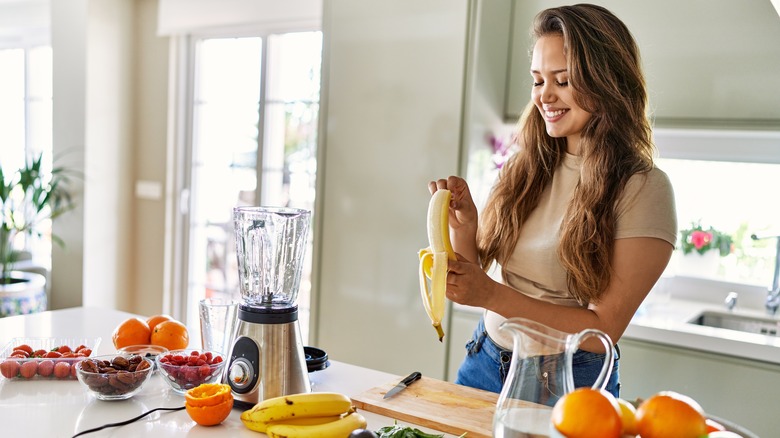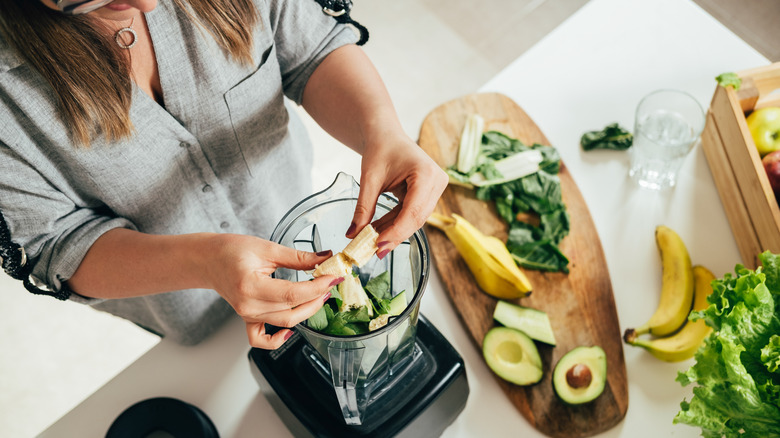The Nutritional Drawback Of Blending Fruit In A Smoothie
Smoothies for breakfast are a great way to start your day with fresh fruit, especially since most people don't get enough fruits and vegetables each day. Although a nice, cold-pressed juice might taste satisfying, you miss out on the pulp and skin that you'd get from eating whole fruits and vegetables. Blending allows you to include the whole plant rather than extracting the juice. You'll also get the same vitamins, minerals, fiber, and antioxidants in a smoothie as if you ate them whole (per The New York Times).
When you whip your fruits and vegetables into a smoothie, this can be beneficial since some fibers will spread more easily in your digestive tract and slow down digestion, which can help stabilize your blood sugar and help you feel fuller for longer. However, you should also be aware that other fibers that help add bulk to your stool and prevent constipation lose this quality the more they're blended. This is the insoluble fiber that gets broken down by the blades of the blender, which could be one of the reasons why you feel hungry a few hours later (per Business Insider).
Breaking down insoluble fiber makes you eat more?
Pediatric endocrinologist Robert Lustig told Mother Jones that blending fruit "shears the insoluble fiber into tiny pieces." Without the insoluble fiber, the soluble fiber can't slow down the absorption of the sugar from the fruit and therefore triggers your body to produce insulin to handle it. He believes blending your fruit rather than eating it whole is just like drinking soda.
However, according to a 2022 study in Nutrients, blending fruits might actually help stabilize blood sugar. People who ate a blended gala apple (without the seeds) and blackberries had less of a boost in blood sugar compared to those who ate the equivalent of whole fruit. The researchers believed that blending fruit helped to release the fiber and other nutrients from the blackberry seeds.
Preventive medicine specialist David Katz told Mother Jones that there still isn't enough research to determine how insoluble fiber breaks down if fruit is blended. However, you don't eat fruit whole, he said. When you chew your food, your mouth also breaks down the insoluble fiber. When a blender already does this for you, you're more likely to consume more. A 2009 study in Appetite found that people who ate an apple before lunch ate less than people who ate applesauce, apple juice, or apple juice with added fiber.
How to make your smoothies more filling
Although the fiber does its job to slow down digestion, The New York Times says that drinking a smoothie might not leave you as satisfied as if you chopped the fruit into a smoothie bowl. You can make your smoothies a little more filling by adding some nut butter, unsweetened Greek yogurt, or protein powder, according to Eating Well.
Rather than making your smoothies all about fruit, you can also add more nutrition by tossing in some leafy greens such as kale or spinach. Oats will blend nicely into a smoothie while giving you a healthy dose of whole grains. Chia, flax, and hemp seeds provide you with heart-healthy fats and filling fiber so you're not reaching for a snack a few hours later.
If you feel your smoothie needs a little more sweetener, add dates rather than sugar, honey, or agave nectar. Dates will digest more slowly than these other sugars.



